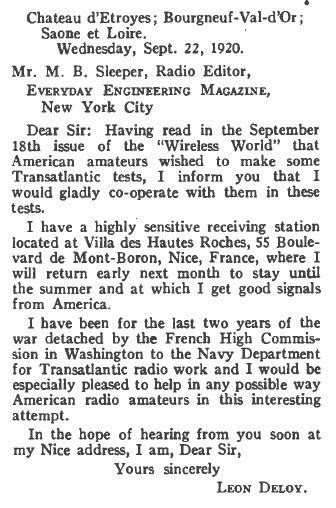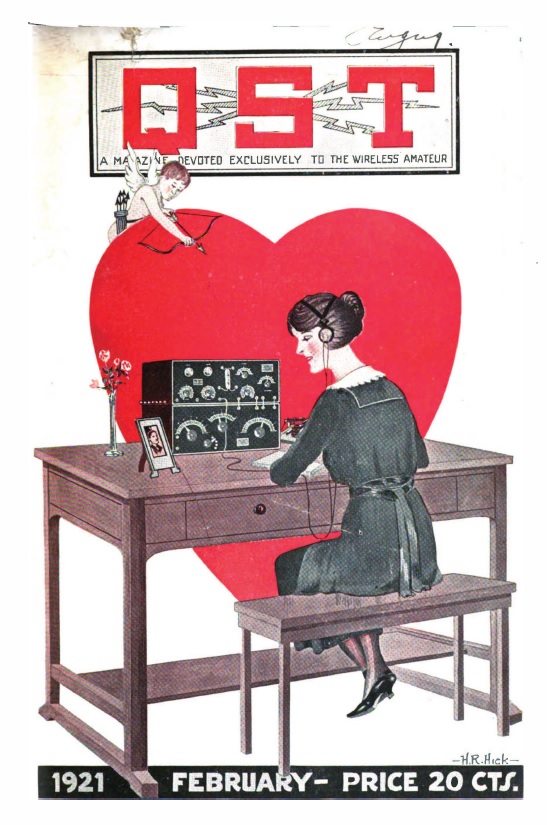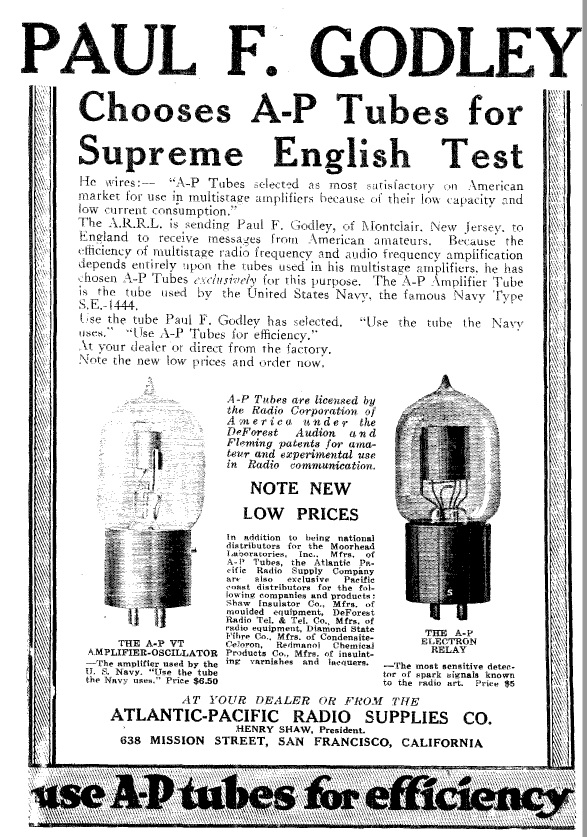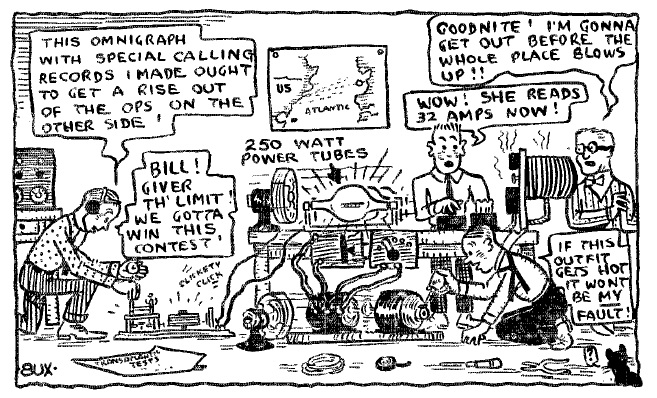Transatlantic Tests 1
Initial Failure Prompts ARRL Plans for further Tests
Why did Kenneth Warner bet his Spring Hat on ARRL success?
In the twenty-first century, a Radio Amateur expects two-way communication (QSOs) with other enthusiasts world-wide, depending only on available propagation. Both may be transmitting and receiving from their homes, using the equivalent power of a domestic light-bulb and with aerials that are relatively small, temporary structures. In the early 1920s this wasn’t the case, but these years saw the dawn of international amateur radio with a series of significant milestones that led over some five years from no amateur transmission ever having been heard on another continent, to intercontinental QSOs becoming commonplace.
A hundred years ago is still relatively recent; the story of the first real long-distance (DX) QSOs starts in the year that our former patron, the Duke of Edinburgh was born, and spans his first years of childhood. Many of us remember the old 2 letter callsign amateurs in our radio clubs when we were younger – the guys who made the first DX QSOs. We are only one generation removed from them – this is history that we can almost touch.
So where was amateur radio in 1920? In the US, amateur operating had re-commenced following the Great War; there was an established network of amateur (Ham) stations across the country, who could relay messages one-to-another from coast to coast or north to south. Sending was nearly all morse code and many used spark based transmitters; they used receivers with wide bandwidths and few components. Technology was progressing with thermionic valve amplifiers, continuous wave transmitters (with valve oscillators), regenerative and superheterodyne receivers all being introduced. In the UK, there were few amateurs and both power and aerial size were regulated, which restricted contacts to local distances. Amateurs were operating on wavelengths no shorter than 200 metres. Commercial stations with huge power were reliably spanning the Atlantic, but radio amateurs had not yet been heard in either direction across the “pond”.
A visionary named Milton Sleeper, of Everyday Engineering, a New York publication, which was soon to be defunct, stepped in with a dramatic proposal for a series of Transatlantic Tests in September 1920:

It is hoped that, during the coming winter, the next transatlantic conquest will be recorded, that is, the transmission, from a 200 meter, 1 kW. experimental station, of radio messages to England.
The first experimenter, to transmit across the Atlantic will set a new standard for 200 meter sets. His name will never be forgotten as long as there are radio experimenters.
Mr Philip R Coursey, of the Radio Review and Wireless World (and Wireless Society of London), whose aid has been requested in handling the receiving arrangements, will have no difficulty in enlisting the most able English operators and the best equipped stations.[1]
A French amateur, Leon Deloy (French 8AB), got wind of the potential tests from an article in Wireless World and wrote to Everyday Engineering expressing interest from his home in Nice; his letter was published in the final edition. Little did Sleeper then know that Deloy would become one of the names that would never be forgotten, but his part in the story comes later.

When Everyday Engineering magazine folded, the ARRL took on responsibility for what would become known as the First Transatlantic Tests. Three nights were planned where US amateurs would transmit and UK amateurs would listen. Nothing was yet planned for the other direction.
From QST, the ARRL journal, in the USA, February 1921:
Transatlantic Sending Tests
Arrangements have not been completed fully at this writing and it is impossible to give schedules, etc., but the plans of Mr Sleeper will be followed with as little change as possible, the American entrants probably transmitting on schedule on the nights of Feb 1st, 3rd, and 5th.[2]

(Copyright ARRL, used with their kind permission)
The Tests involved US amateurs sending morse using either CW or spark transmitters. Their signals included callsigns and unique codes to allow reception to be verified. Results of the Tests were to be sent back to the US by commercial radio telegram.
The UK publication, Wireless World, announced the disappointing outcomes on 5 March 1921:
In the early hours of the 2nd, 4th and 6th of February (1921), twenty-five amateur wireless stations in the United States were scheduled to transmit signals with a power of 1kW on a wavelength of 200 metres, for the purpose of establishing communication with enthusiasts on this side of the Atlantic. Over 250 wireless amateurs in the United Kingdom enrolled their names with Mr Philip R Coursey, BSc, the organiser of the tests in England, and by the closing date, for the reception of reports (February 14th), some 30 logs of signals received were forwarded to The Wireless World.
The work of checking the logs against the transmission programme has just been completed, and in our next issue we hope to publish a detailed consideration of the results obtained. Meanwhile we may state that although every log has been carefully perused and checked, not one entrant has received a single word or signal which can unquestionably be attributed to an American amateur station.[3]

QST, May 1921, confirmed that something had been heard but reception could not be verified. At this time, Kenneth Warner, Secretary of the ARRL, bet his Spring Hat that if they were to send an amateur from the US over to England, with the latest radio technology, reception of US amateurs across the Atlantic would be achieved.
In the UK, the Tests’ failure was confirmed in Wireless World, 2 April 1921, although prizes were still awarded! A combination of atmospheric noise, interference from harmonics from commercial stations and heterodynes radiated from other UK receivers made reception of the weak 200m signals very difficult. QRM (interference) and QRN (static noise) are not new phenomena. Of course, with the benefit of hindsight, we recognise that 200m was not the most appropriate wavelength for Transatlantic amateur radio communications, but it would be at least a couple of years before amateurs moved to shorter wavelengths.
Transatlantic Tests – The Prize-Winning Description, by W.R. Wade
Owing to atmospherics and radiating waves from valves, probably local, on account of their intensity, reception was almost impossible, and it is quite likely that the signals recorded are not the American amateur signals at all. They were, however, on 200 metres wave and were continuous wave signals (not spark transmitters).
The commercial stations which interfered with the reception of signals were transmitting on waves above 600 metres, so it was probably a harmonic of the wave which caused the trouble.[4]
Apart from the other reasons for failure, it was recognised that three nights were too few, as conditions were known to vary. It was also known that winter conditions favoured DX propagation on 200m, so the next series of Tests would have to wait until December 1921.
Wireless World, 17 September 1921, takes up the story:
Short-Wave Signalling Across the Atlantic
It has been proposed by the American Radio Relay League that another series of tests shall be held this autumn, in which a more serious attempt will be made to definitely establish communication, and it is hoped that all enthusiastic wireless amateurs in this country will again co-operate in listening for the American signals.[5]
The first ARRL convention was held in Chicago in August 1921 and it was here that plans for the second Transatlantic Tests – again West to East – were hatched. But the plans also included sending an ARRL representative, equipped with the latest receivers, to make sure that anything that could be heard, would be heard.
From QST, October 1921:
Godley to England to Copy Transatlantics
The (ARRL) Traffic Manager came before our Board of Direction at its meeting at Chicago during the Convention and after announcing the plans for the second series of Transatlantic Tests this winter, proposed that the ARRL send a qualified American amateur overseas to listen for our stations on American apparatus, to supplement the efforts of the British amateurs.
It was agreed that Paul F Godley, originator of the three-circuit tuner as far as amateur, work is concerned, was the logical man; that in the opinion of the Board Mr Godley was America’s best authority and best operator in short wave receiving. Mr Godley was asked if he would go to England under the direction of our Operating Department and has accepted the invitation. He sails on the Aquitania on November 15th![6]

(Copyright ARRL, used with their kind permission)
Naturally there was some disquiet expressed in the UK at the prospect of an American being sent to show us how to do it – from Wireless World, 29 October 1921:
Short Wave Atlantic Signals
A Plea for General Co-operation in a great effort to attain success
One can hardly over-estimate the scientific interest which the successful reception of short wave signals over this distance would create.
American amateurs have considered the question of sufficient importance to vote a considerable sum of money, through the ARRL, to send over to this country one of America’s experts in short wave reception, in order that, in endeavouring to get the signals, he may know for himself the difficulties to be encountered.
The American magazine QST commented on the lack of success in the tests carried out last year.
If our efforts were so criticised then, one dares not think what would be said if a “good US Amateur” must come over here to show us how it should be done.[7]

(Copyright ARRL, used with their kind permission)
And in Wireless World, 26 November 1921:
The Transatlantic Tests
Mr P F Godley, who is being sent over here by the American amateurs, will bring with him his own receiving equipment of a sufficiently flexible nature to cover the above-mentioned range of wavelengths, but obviously those American stations who are nearest to 200 metres on which wavelength most of us will be listening will have a better chance of getting through. Mr Godley is determined to pick up the signals if it is at all possible to do so, so for the honour of British amateurs and experimental wireless we appeal to all radio enthusiasts in this connection either to make every effort to pick up the signals – using a non-radiating receiver with a separate heterodyne so as to avoid interfering with other listeners – or to keep quiet during the test periods, and to avoid either transmitting or receiving.[8]
Paul Godley was variously referred to in the US as “Paragon Paul” for his Paragon regenerative combination (receiver design) or one who qualifies as being a “hard boiled ham” – an interesting mixture of metaphors.
The scene was set for the second series of Transatlantic Tests.
References
[1] Radio Editor Milton B Sleeper, Everyday Engineering Magazine, Everyday Mechanics Co Inc, September 1920, p. 544
[2] Transatlantic Sending Tests, QST, February 1921, p. 20
[3] Transatlantic Amateur Wireless, Disappointing Results of First Tests, Wireless World, 5 March 1921, pp. 827-828
[4] W. R. Wade, Transatlantic Tests, The Prize-Winning Description, Wireless World, 2 April 1921, pp. 16-19
[5] Philip R Coursey, Short-Wave Signalling Across the Atlantic, Wireless World, 17 September 1921, pp. 383-384
[6] Godley to England to Copy Transatlantics, QST, October 1921, pp. 29-32
[7] Short Wave Atlantic Signals, Wireless World, 29 October 1921, pp. 482-483
[8] The Transatlantic Tests, Wireless World, 26 November 1921, pp. 544-545
Other pages in this section










